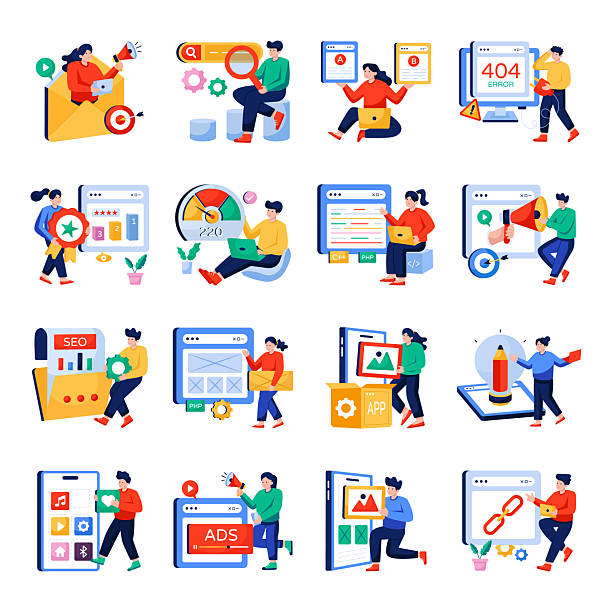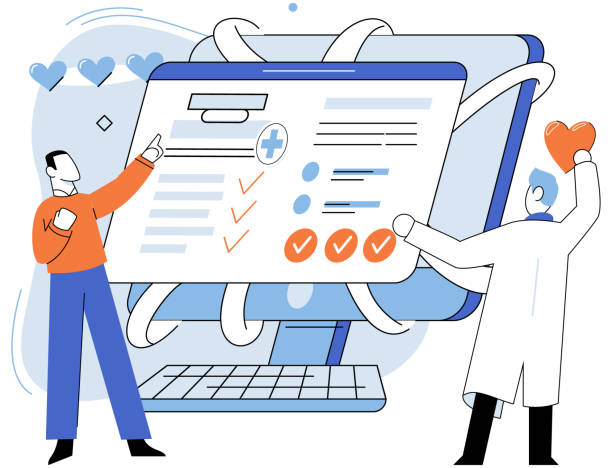Why is fast website design so important?

In today’s digital world, website speed is not just a competitive advantage; it has become an absolute necessity.
#User_Experience #SEO #Bounce_Rate are among the most important factors directly affected by website loading speed.
When we talk about fast website design, it’s about optimizing all technical and content aspects of a website to provide a smooth and delay-free experience for users.
Numerous studies have shown that even a one-second delay in page loading can significantly increase user bounce rates and lead to the loss of potential customers.
This is especially critical for businesses looking to increase sales and engage with their audience.
Imagine a user searching for specific information or a product, and after clicking your link, they have to wait for the page to load.
This wait can quickly turn into frustration and drive the user towards competitors.
Fast website design also plays a very important role in improving website rankings in search engines like Google.
Google’s algorithms consider site speed as one of the key factors in page ranking and place slower websites lower in the results.
This further highlights the high importance of fast website design, and this is an “explanatory” aspect.
Therefore, investing in website speed optimization is an investment in your business’s long-term success.
It not only helps attract and retain users but also contributes to your online credibility and branding.
SEO and user experience are two main pillars of any successful website, both heavily dependent on speed.
Does your company’s website create a professional and lasting first impression in the minds of potential customers? Rasawab, with its professional corporate website design, not only represents your brand’s credibility but also opens a path for your business growth.
✅ Create a powerful and trustworthy brand image
✅ Attract target customers and increase sales
⚡ Get free consultation
Key Factors Affecting Website Speed

To achieve fast website design, it’s necessary to identify and optimize various factors that affect website performance.
#Server #Coding #Images are three main factors that have the greatest impact on site loading speed.
First, your website’s hosting server plays a central role.
Choosing a powerful and high-quality hosting with sufficient resources and close to your audience can make a significant difference in speed.
Shared services are generally slower compared to dedicated or VPS servers.
Next, the quality of website coding is crucial.
Disorganized code, extra scripts, and unnecessary CSS can severely reduce loading speed.
Code optimization, compression of HTML, CSS, and JavaScript files are essential steps for fast website design.
Also, the size and format of images and media files uploaded to the site significantly impact speed.
Large, unoptimized images can greatly increase page loading time.
Using modern formats like WebP and compressing images without reducing quality are fundamental solutions for improving site speed.
In addition, the number and efficiency of plugins and external scripts (such as analytical tools, fonts, and videos) should also be reviewed.
Each additional script can create new HTTP requests and add to the overall loading time.
A precise “analytical” approach to these factors is the cornerstone of any successful effort for fast website design.
By identifying and addressing weaknesses in each of these areas, significant performance can be achieved.
Optimizing Images and Media for Speed

Images and media files are often the biggest contributors to website slowness, so optimizing them is a crucial step towards fast website design.
#Compression #WebP #CDN are among the most important techniques in this regard.
The first step is image compression.
Many online tools and WordPress plugins exist that can reduce image file sizes without a noticeable loss in quality.
This allows the user’s browser to download smaller files, thereby reducing loading time.
Using modern image formats like WebP is also highly recommended.
The WebP format offers better compression than JPEG and PNG, helping your website load faster with the same visual quality.
Implementing Lazy Loading is another effective method.
With this method, images and videos are only loaded when the user scrolls to the relevant section of the page, not from the very beginning.
This reduces the initial page load and improves the user experience.
Additionally, using a Content Delivery Network (CDN) for images and media can significantly increase their delivery speed to users worldwide, as the CDN serves content from the server closest to the user.
These guidelines are part of a comprehensive strategy for fast website design.
Proper implementation of these techniques not only helps website speed but also optimizes server resources and ultimately leads to a better user experience.
| Method | Description | Impact on Speed | Advantages | Potential Disadvantages |
|---|---|---|---|---|
| Compression | Reducing image file size by removing unnecessary data or slightly reducing quality | Reduces image loading time | Simplest and most effective method, maintains relative quality | Slight quality reduction with heavy compression |
| WebP Format | Modern image format with better compression than JPEG/PNG | Smaller size with similar quality, faster loading | Excellent performance, wide browser support | Requires format conversion, some older browsers do not support |
| Lazy Loading | Loading images only when they enter the user’s viewport | Reduces initial page load, improves Core Web Vitals | Better user experience, bandwidth saving | May affect SEO in some scenarios |
| Using CDN | Delivering content from the server closest to the user | Reduces latency, improves global speed | Increases speed for international users, increases stability | Additional cost, setup complexity |
The Role of Optimized Coding in Fast Website Design

The quality of website coding directly affects its loading speed and forms a significant part of fast website design.
#Minification #Asynchronous_Loading and using clean and optimized code are fundamental principles in this area.
Minification is a process where all unnecessary characters such as white spaces, new lines, and comments are removed from HTML, CSS, and JavaScript files.
This reduces file size, thereby improving their loading speed.
Also, combining CSS and JavaScript files into one or more larger files can reduce the number of HTTP requests, which in turn contributes to greater speed.
Asynchronous Loading for JavaScript scripts is also very important.
By default, browsers pause their execution when encountering a script until the script is loaded and executed.
With asynchronous loading, the browser can continue parsing and rendering the rest of the page while the script loads in the background.
This “specialized” technique significantly improves the user experience and is one of the most important factors in fast website design.
Furthermore, using efficient algorithms and optimized databases in the website’s backend is also crucial.
A poor database query or an inefficient function can severely increase server response time.
Developers should consider code optimization at all stages of fast website design and use code analysis tools to identify weaknesses and improve performance.
This approach ensures that the website is not only beautiful and functional but also performs at peak speed.
Are your e-commerce website visitors leaving before making a purchase? Don’t worry anymore! With Rasawab’s professional e-commerce website design services, solve the problem of not converting visitors into customers forever!
✅ Significant increase in conversion rate and sales
✅ Unique and engaging user experience
⚡ Contact us now for a free consultation!
Caching Techniques and Their Impact on Site Speed

One of the most powerful strategies for achieving fast website design is the correct use of caching techniques.
#Caching #Browser #Server play a key role in reducing page loading time as methods for temporary data storage.
Browser Caching allows the user’s browser to store static website files (such as images, CSS, and JavaScript files) on the first visit.
This means that on subsequent visits to the same site, the browser loads these files from its cache instead of re-downloading them from the server.
This process significantly increases page loading speed and reduces the load on the server.
Server-side Caching and Object Caching are other types of caching that operate at the server level.
Server caching stores copies of ready-made pages or database query results so that they don’t need to be reprocessed for every request.
This “educational” approach is crucial for web developers, as it can significantly reduce server response time and turn your website into an excellent example of fast website design.
Using advanced caching systems like Varnish or Redis can revolutionize the performance of large and high-traffic websites.
By correctly implementing caching strategies, you can ensure that your website content reaches users at the highest possible speed, even during peak traffic times.
This optimization not only improves the user experience but also preserves server resources and contributes to greater website stability in the long term, all of which are primary goals in fast website design.
Choosing Suitable Hosting and CDN for Fast Website Design

Choosing appropriate hosting and using a Content Delivery Network (CDN) are two fundamental pillars in achieving fast website design.
#Hosting #CDN; server quality and geographical location directly impact website loading speed.
Shared hosting might suffice for small, low-traffic websites, but for larger websites or those seeking fast website design with high performance, options like Virtual Private Servers (VPS) or Dedicated Servers are needed.
These options provide more resources and prevent interference from other websites.
Also, choosing a datacenter that is geographically closest to the majority of your audience can minimize latency and increase loading speed.
This is “good news” for businesses with international audiences.
A CDN is a global network of servers that stores cached copies of your website’s content (such as images, videos, and static files).
When a user visits your website, the CDN delivers the content from the server closest to that user.
This reduces physical distance and, consequently, significantly increases content delivery speed.
Using a CDN not only boosts speed but also enhances website stability against high traffic or DDoS attacks.
For fast website design, choosing a combination of high-speed hosting and a reliable CDN is a smart investment that will yield tangible and sustainable results and unlock the full potential of your fast website design.
Website Speed Measurement and Analysis Tools

After implementing optimization measures, the next step to ensure fast website design is continuous measurement and analysis of website performance.
#PageSpeed_Insights #GTmetrix and Pingdom Tools are among the most well-known tools available for this purpose.
Google PageSpeed Insights is a free tool provided by Google that analyzes your website’s speed for both desktop and mobile versions.
This tool not only provides an overall performance score but also offers specific suggestions for speed improvement, such as image optimization, eliminating render-blocking JavaScript and CSS, and enabling Gzip compression.
GTmetrix is another powerful tool that provides more detailed reports, including a Waterfall chart showing the loading details of each page component.
This information is very useful for developers to precisely identify speed bottlenecks.
Pingdom Tools is also another popular tool that provides similar information to GTmetrix and helps you check your website’s performance from different parts of the world.
These tools raise a “questionable content”: why do they show different scores for the same website? The answer lies in different measurement methods, varying test servers, and their geographical locations.
More important than the absolute score is following the recommendations provided by these tools for continuous improvement.
Regular use of these tools for fast website design allows you to measure the impact of implemented changes and ensure that your website always operates at the highest possible speed.
This iterative process is key to maintaining and improving fast website design.
| Tool | Key Features | Main Focus | Report Detail Level | Usability |
|---|---|---|---|---|
| Google PageSpeed Insights | Performance score (0-100) for mobile and desktop, Core Web Vitals, optimization suggestions | UX and Google SEO ranking | Medium (practical suggestions) | Easy (for all levels) |
| GTmetrix | PageSpeed and YSlow scoring, Waterfall chart, page load video, Core Web Vitals | Deep technical performance analysis | High (for developers) | Medium to Advanced |
| Pingdom Tools | Load time, page size, number of requests, performance chart, testing from different geographical locations | Website performance and availability | Medium (general performance info) | Easy |
Responsive Design and Mobile Loading Speed

In the current era, where most users access the internet via mobile devices, responsive design and high mobile loading speed have become one of the most important requirements for fast website design.
#Responsive #Mobile; Google, with the introduction of Mobile-first indexing, places special emphasis on website performance on mobile devices.
This means that for ranking your website, Google first checks its mobile version.
Therefore, if your website is slow on mobile or provides a poor user experience, your ranking in search results will suffer.
Responsive design allows your website to automatically adapt to the user’s device screen size, but this alone is not enough for speed.
Optimizing images for smaller displays, removing unnecessary mobile scripts, and using optimized formats like AMP (Accelerated Mobile Pages) are other actions that help increase mobile loading speed.
AMP is an open-source framework designed to create fast and accessible web pages on mobile.
This “guidance” approach helps you not only satisfy mobile users but also benefit from the SEO advantages Google grants to mobile-friendly websites.
Ultimately, focusing on fast website design for mobile means providing a seamless and satisfying user experience for all users, regardless of the device they use.
Are you losing customers because of your e-commerce website’s outdated appearance or slow speed? Rasawab’s expert team solves these problems with professional e-commerce website design!
✅ Increase customer trust and your brand’s credibility
✅ Stunning speed and excellent user experience
Get a free consultation with Rasawab right now ⚡
Security and Speed: Balance or Conflict?

Often the question arises whether website security contradicts fast website design or if a balance can be struck between them.
#Security #SSL; in fact, in many cases, modern security solutions can also help improve speed.
For example, using an SSL certificate to encrypt communications not only ensures your site’s security but often also improves loading speed by enabling the HTTP/2 protocol.
HTTP/2, which works via SSL, allows for simultaneous loading of files, which itself leads to reduced page loading times.
In the past, firewalls or DDoS protection systems might have slightly added to site speed, but today many of these services are designed not to negatively impact performance and even assist with fast website design by compressing content and caching.
This is an “analytical” approach that shows that by choosing the right security tools and solutions, both security and speed can be optimized simultaneously.
Opting for a CDN that also offers security features like Web Application Firewall (WAF) and DDoS protection can cover both aspects.
These CDNs, by distributing traffic and filtering malicious requests, not only keep your website secure but also increase speed by delivering content from the closest server.
Therefore, with proper planning and implementation, security and fast website design can complement each other and provide a powerful and efficient website.
Conclusion and the Future of Fast Website Design

In conclusion, it can be said that fast website design is no longer a luxury option but a strategic necessity for every business and individual operating in the online space.
#Continuous_Optimization #HTTP/3; from improving user experience and reducing bounce rates to enhancing search engine rankings and increasing conversion rates, website speed plays a vital role in all aspects of online success.
This article has examined key factors such as image optimization, clean coding, caching, choosing appropriate hosting and CDN, and the importance of responsive design.
Remember that fast website design is not a one-time process but requires “continuous optimization.”
With technological advancements and changing user expectations, your website must also be optimized in sync with these changes.
The future of fast website design is also very exciting.
With the advent of protocols like HTTP/3, built on UDP and promising unprecedented speeds and more stable connections, as well as newer technologies like Serverless Computing and Edge Computing, websites will become even faster in the future than they are today.
This is an “entertaining” and inspiring vision of the future.
Investing in knowledge and tools related to fast website design ensures that your website is not only competitive now but also ready for future challenges and opportunities.
By continuously pursuing and implementing best practices, you can ensure that your website always performs at its peak and provides the best possible experience to users.
Frequently Asked Questions
| Question | Answer |
|---|---|
| What is fast website design? | Refers to the process of building a website that is developed and launched in a short time, usually with the use of ready-made platforms or optimized methods. |
| Why is speed important in website design? | High speed improves user experience, increases SEO ranking, and boosts the conversion rate of visitors into customers. |
| What tools are available for fast website design? | Content Management Systems (CMS) like WordPress, Joomla, and Drupal, drag-and-drop website builders, and fast web development frameworks. |
| What are the advantages of using CMS for fast design? | Ready-made templates, diverse plugins, easy content management without much coding, and a large user community for support. |
| Does fast website design mean low quality? | Not necessarily. With the right tools and methods, a high-quality website can also be designed quickly. |
| What factors influence website design speed? | Project complexity, designer’s experience, choice of platform or tool, readiness of content and images, and effective communication with the client. |
| How is responsive design included in fast website design? | Most fast design templates and tools are responsive by default and require little to no configuration. |
| How much does fast website design cost? | The cost varies depending on complexity, chosen platform, and additional services, but it is usually less than custom design from scratch. |
| How can the loading speed of a designed website be increased? | Image optimization, browser caching, file compression, using a CDN, and choosing suitable hosting. |
| When is fast website design a suitable option? | For small businesses, startups, personal websites, or projects that need quick launch and have a limited budget. |
And other services of Rasawab Advertising Agency in the field of advertising
Smart Digital Branding: A fast and efficient solution for increasing click-through rates with a focus on Google Ads management.
Smart SEO: An effective tool for user engagement with the help of custom programming.
Smart Customer Journey Map: An innovative service for increasing click-through rates through attractive user interface design.
Smart Advertorial: An innovative service for increasing website visits through optimizing key pages.
Smart SEO: An effective tool for attracting customers by using real data.
And over hundreds of other services in the field of internet advertising, advertising consultation, and organizational solutions.
Internet Advertising | Advertising Strategy | Advertorial
Resources
Comprehensive Website Design Guide
SEO Optimization Tips
Online Business Success
Fast Website Loading
? For your business, a brighter future awaits with Rasawab Afarin’s professional services. From SEO-optimized website design to digital marketing strategies, we are with you every step of the way to ensure a powerful online presence.
📍 Tehran, Mirdamad Street, next to Bank Markazi, Kazerun Jonubi Alley, Ramin Alley, No. 6

